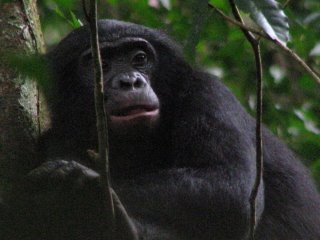All images by Alexander Georgiev
 From October to December 2006, with the help of local trackers, I followed the bonobos of the Hali-Hali community at Kokolopori. At this site tracking of bonobos has started back in 2002. Since then the Bonobo Conservation Initiative and their local partner organisation, Vie Sauvage, have worked in this part of the Congo to protect the apes, that traditionally are not hunted by the local people.
From October to December 2006, with the help of local trackers, I followed the bonobos of the Hali-Hali community at Kokolopori. At this site tracking of bonobos has started back in 2002. Since then the Bonobo Conservation Initiative and their local partner organisation, Vie Sauvage, have worked in this part of the Congo to protect the apes, that traditionally are not hunted by the local people.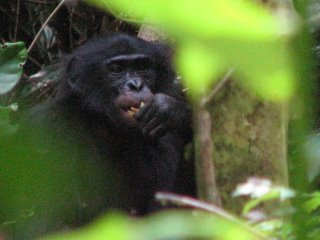 A lot of the time during October - December the bonobos fed on the seeds of a tree, known locally as Waka . They ate them in the canopy, but a lot of time they just foraged for them on the ground, spending hours picking them up from the leaf litter, not travelling very far in between.
A lot of the time during October - December the bonobos fed on the seeds of a tree, known locally as Waka . They ate them in the canopy, but a lot of time they just foraged for them on the ground, spending hours picking them up from the leaf litter, not travelling very far in between. Here a mother feeds on the same Waka seeds, moving slowly as she picks them up, puts them in her mouth and gets rid of the outer husky coating.
Here a mother feeds on the same Waka seeds, moving slowly as she picks them up, puts them in her mouth and gets rid of the outer husky coating. Two mothers having a bit of a grooming. The bonobos on this day spent a couple of hours feeding on the seeds of the Waka tree - not on the ground but up in the canopy. Then some of them had a grooming break.
Two mothers having a bit of a grooming. The bonobos on this day spent a couple of hours feeding on the seeds of the Waka tree - not on the ground but up in the canopy. Then some of them had a grooming break.  A mother bonobo, relaxing. Her baby is just about visible in her lap area.
A mother bonobo, relaxing. Her baby is just about visible in her lap area.
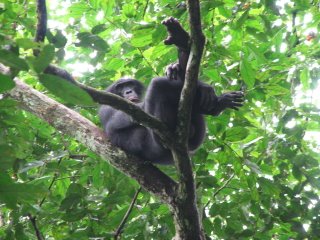 The male, who we saw only rarely with the bonobos that we followed. The dominant often chased him. Because of his characteristically long face, I called him, quite unimaginatively, Longface.
The male, who we saw only rarely with the bonobos that we followed. The dominant often chased him. Because of his characteristically long face, I called him, quite unimaginatively, Longface.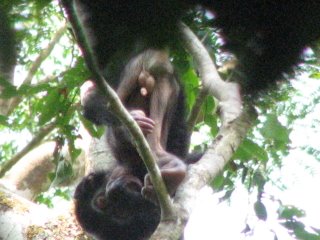 A baby boy. Son of the female that I called Clownface. The area around hers, and her offspring's mouth was very white. Hence the name.
A baby boy. Son of the female that I called Clownface. The area around hers, and her offspring's mouth was very white. Hence the name. 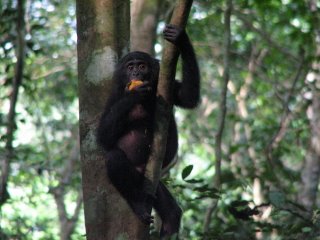 A juvenile eating the fruit of one of the big trees in the forest - 'Baalanga' in the local language. Known also as Irvingia.
A juvenile eating the fruit of one of the big trees in the forest - 'Baalanga' in the local language. Known also as Irvingia.
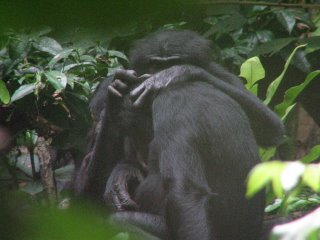 One of the adult female mothers grooming the dominant male. During the three months at Kokolopori I did not see once a male groom another male. It would be either females grooming one another, or a male-female grooming combination. Big difference to what happens in chimps, where males groom each other a lot.
One of the adult female mothers grooming the dominant male. During the three months at Kokolopori I did not see once a male groom another male. It would be either females grooming one another, or a male-female grooming combination. Big difference to what happens in chimps, where males groom each other a lot. One of the males. During the entire time in the field I saw only 3 different adult males hanging out with the party we followed. Most of the days there were only two of them - Rafaelo, and another, dominant individual who is yet to be named (pictured here).
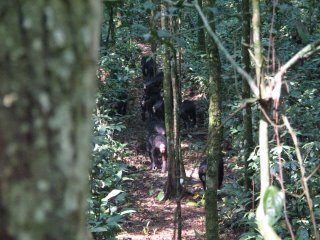 The last day that I saw the Hali-Hali bonobos, shortly before Christmas 2006. The entire party, some 5 mothers, 2 young females, 2 adult males and a bunch of juveniles travelled for nearly 1 km along one of the trails we cut in the forest. They were heading straight North towards the area where the primary forest gives way to the agricultural fields of the villagers. There a kind of transitional belt of 'disturbed forest' lays - a thick tangle of terrestrial herbaceous vegetation (THV), often more than 2 m in height, which makes moving around very slow and difficult - especially so for human observers.
The last day that I saw the Hali-Hali bonobos, shortly before Christmas 2006. The entire party, some 5 mothers, 2 young females, 2 adult males and a bunch of juveniles travelled for nearly 1 km along one of the trails we cut in the forest. They were heading straight North towards the area where the primary forest gives way to the agricultural fields of the villagers. There a kind of transitional belt of 'disturbed forest' lays - a thick tangle of terrestrial herbaceous vegetation (THV), often more than 2 m in height, which makes moving around very slow and difficult - especially so for human observers.